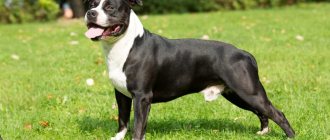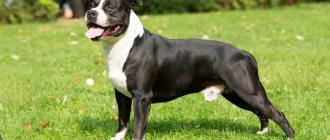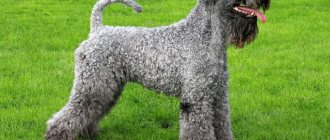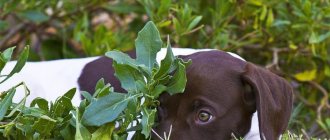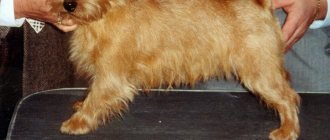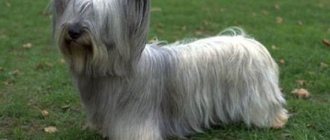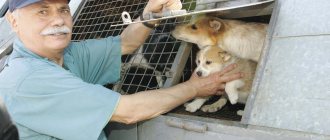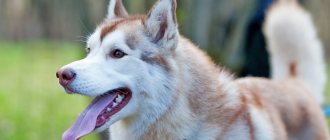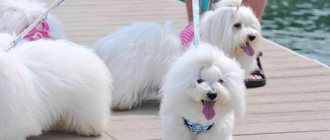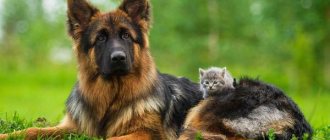The American Staffordshire Terrier breed is legendary. The opinion is firmly entrenched in people's minds that these are natural-born killers who should not be allowed close to children and other animals. As often happens with “truths”, this one is fundamentally wrong.
In fact, purebred Amstaffs are one of the friendliest representatives of the canine world. They are infinitely devoted to their owners and love to play with children. All stories about atrocities committed by such dogs are the result of mistakes made by people who buy a dog without thinking about whether they can raise the pet correctly.
History of the origin of the breed
The history of the Staffordshire Terrier breed began in Great Britain in 1800. The ancestor of these noble animals is the English bulldog, in which fighting qualities have been selected for years. Initially, dogs were shown sparring with rats. When the cruel sport of dog fighting became popular, a faster animal was needed. Cynologists began crossing the bulldog with the smooth fox terrier and the English terrier. This is how the Staffordshire Bull Terrier (or Staffbull) breed appeared.
After the ban on dog fighting in England, the fashion for “pit bulls” did not go away. They became favorites of the local nobility.
The Staffordshire Bull Terrier became popular in America, where representatives of the breed began to be imported en masse in the 70s of the 19th century. Here the dogs were crossed with large dogs. The resulting individuals were called American Bull Terriers. The result of the painstaking work of the breeders was their official recognition. The first description of the Staffordshire Bull Terrier breed was adopted in the USA in 1935.
In 1972, the standard was registered by the International Canine Federation, receiving its modern name - American Staffordshire Terrier. The dogs differed from their ancestors from Foggy Albion in their massiveness and power. They were used in a variety of areas: they took part in battles, hunted big game (boars, bears), and guarded farms.
Since then, breed standards have remained virtually unchanged. According to their purpose, Staffords became primarily companions.
Description of the breed
The Amstaff gives the impression of a powerful, strong, very strong, proportionally built dog.
The appearance of a purebred dog must meet the following characteristics:
- small head;
- the muzzle is wide, with pronounced muscles and transition to the forehead;
- The ears are set high; if they are not cropped, they should stand up. Hanging dogs are recognized as a breed defect;
- The eyes are small, dark brown, deep-set. Irises of all shades of blue are not allowed;
- powerful jaws;
- nose is large and black;
- paws are strong. The front ones are set wide apart;
- the neck is massive and wide;
- the back is wide, straight;
- the stomach is tucked;
- massive chest;
- the paw pads are medium-sized, the toes are pressed tightly together;
- the tail is set low, straight, short, tapering to the tip.
According to the breed standard, the American Staffordshire Terrier moves quickly, with a slight spring when walking. Lethargy and excess body weight are not allowed.
As mentioned above, the direct ancestors of the Amstaff are the bulldog and terrier, so cynologists are still struggling to ensure that individual individuals do not deviate towards one or another breed.
Experts distinguish three types of Staffords:
- proportional – closest to the approved standard. This includes dogs with wide shoulders, a voluminous chest, and the correct length of the lower back. Active and inquisitive;
- b the uldogoid type weighs more than 45 kg, has a rough build, a short neck, and is constrained in movement due to poor angles of the hind legs and turned out elbows;
- Terrier-like staffs weigh less than 30 kg, have an elongated, narrow mouth, a long neck, without a pronounced reversal of the sternum. They create the general impression of a puny animal. At the same time, they are restless, but get tired quickly, since they have an incorrect angle of articulation of the scapula with the shoulder.
The latter two species are more prone to hereditary diseases of the heart and joints, in comparison with representatives of the proportional variety breed.
Size and weight
The breed standard provides for the following characteristics of Amstaffs:
- males – height 46-48 cm, weight 25-30 kg;
- females – height 43-46 cm, weight 22-25 kg.
Males look more powerful and muscular than females.
Color and coat type
The Staffordshire Terrier's coat is short, straight, hard to the touch, and lies close to the body. A healthy dog has shiny, thick hair.
Faults include soft or sparse coat, defects include silky, long, wavy, sparse or dull coat.
Almost all solid Stafford colors are allowed: from black to cream. In bicolor dogs, white spots should cover no more than 20% of the body.
Solid white or blue colors are considered a fault.
Purebred Staffordshire Terriers can also be brindle (when stripes of a darker color are noticeable on the main color) or piebald.
Red-brown and black with red tan (Rottweiler color) coat colors are considered undesirable.
How to choose a puppy
Choosing a puppy is an important and responsible moment, because it will become a member of the family for many years. Here are the main aspects that require attention:
- the appearance of the puppy;
- activity and interest in what is happening;
- conditions of detention;
- Amstaff colors according to the breed standard;
- purchase price;
- parents' indicators.
Healthy puppy
Healthy-looking puppies are dense, strong and playful. The coat is shiny and lies smooth. The puppy should not have any rashes or scratches on its skin. Amstaff colors are a matter of taste; compliance with the breed standard is important. It is worth examining his tummy: if it is too swollen, this indicates infection with helminths.
You can tell if a puppy is healthy by its face
The fact that the puppies are healthy can be determined by examining their faces. The eyes are clean, have a pleasant shine, the nose is moist. There is no discharge or odor around the ears. Another point is the scissor bite. Also, the dog should not have signs of rickets: curvature of the paws, deformation of the joints.
Behavior
Healthy puppies are active and playful. They are keenly interested in what is happening, including the arrival of potential owners. It is not advisable to take an Amstaff who in every possible way avoids contact with people and does not let himself be handled. Cowardice is an unsuitable trait for a dog; it does not go away as it grows older and even becomes a reason for disqualification.
Important! To make it easier to choose the colors of the Amstaff and a particular puppy, it is worth observing several litters. It is preferable to take the dog from a home where you can see what the mother and other puppies look like.
Another important point is the gender of the puppy. Here you should be guided by the characteristics of sexual dimorphism and personal preferences. There is a so-called “cross-selection rule”: it is better for the owner to purchase a female dog, and for the owner to purchase a male dog.
Males are more active and energetic, tend to dominate and can be stubborn at times. Bitches, in comparison, are flexible, gentle, their intellect is better developed, and their emotional perception is more subtle. There is also a difference in the search for a partner: in females, sexual heat is observed only during the period of heat, while males are passionate about it all year round.
Why buy a puppy
Amstaffs have different colors
When purchasing a puppy, you should decide on the purpose of the purchase. The dog will be just a pet, whether breeding or participation in exhibitions is planned, desired Amstaff colors (brindle, black, blue, white Amstaff). From this point of view, puppies are:
- Show class. These dogs have all the features that correspond to the breed standard, and their advantages are clearly expressed. They are purchased by people who want to participate in exhibitions, breeding is possible.
- Breed class. Such dogs do not have significant deviations from the breed standard. They can participate in exhibitions, but are mainly purchased for breeding.
- Pet class. Such a dog may have an atypical color or other parameter that does not correspond to the breed standard. Although pet-class Amstaffs do not take part in breeding, these deviations from the standard do not in any way affect the dog’s health. She will become a wonderful pet with the character traits typical of all Amstaffs.
An important factor is the price. Puppies from professional breeders may cost more. But this price includes the cost of care and veterinary care for dogs, as well as creating optimal living conditions for them.
Health and illness
Despite their good health, staffs have some hereditary diseases.
The most common of them:
- flatulence;
- hearing impairment (up to its absence);
- hip dysplasia;
- entropion of the eyelid;
- arthritis;
- cataract;
- pathologies of the thyroid gland;
- progressive retinal atrophy;
- heart failure;
- cataract;
- allergies.
The breed is prone to developing various forms of skin cancer. In addition, if the dog is poorly socialized, he will grow up prone to fights with other dogs. This results in various injuries. Wounds can fester and lead to the spread of infection throughout the body.
Lifespan
American Staffordshire Terrier dogs have strong innate immunity. With proper care and good genetics, their average life expectancy is 10-12 years.
Vaccination will help minimize the risk of your pet contracting deadly infections. The first vaccinations for an Amstaff puppy should be given at two months of age.
Next, follow the calendar compiled by the veterinarian. Only an absolutely healthy dog can be vaccinated, having previously undergone a deworming procedure. In the first two weeks after vaccination, the animal should be protected from stress and communication with relatives should be limited.
The Staffordshire Terrier rarely gets sick, but in cold seasons it is better to take him out for walks in special clothes.
Particular attention should be paid to the problematic aspects of dogs of this breed.
Mating
Bitches older than 16 months are allowed to breed, males - after 18 months. To determine the readiness of the dog, you need to contact the kennel club. There, the instructor will select several males, from which the owner will choose a sire.
Health, compliance with the standard, colors (black, blue, brindle, white Amstaff) are assessed. Basic Rules:
- the bitch is brought to the dog, and not vice versa;
- two weeks before estrus, deworming is carried out;
- On the first or second day of estrus, they contact the kennel club to look for a male.
Amstaff puppies
Astaff is an excellent protector, strongly attached to his owner and dependent on his character and mood. Raising this dog requires a competent, consistent approach. Such a pet will become a devoted friend and cheerful companion.
Amstaff: Affectionate pet and loyal protector
Amstaff is a dog with a rather contradictory character, physically powerful and at the same time a sensitive and gentle dog, ready to take a leadership position and touchy in response to what he considers an unfair treatment.
6.8 Overall Characteristics 6Editor's Summary Aggression 6 Adaptability 8 Activity 10 Weight 8 Training 6 Friendliness 4 Playfulness 4 Intelligence 4 Noise 4 7.5User Summary: Aggression 4.3 Adaptability 8.3 Activity 10 Weight 7 Training 8.3 Friendliness 8.7 Playfulness 9.3 In intellect 8 Noise 3.3 Add your review | Read reviews and comments
American Staffordshire Terrier: character and intelligence
It is believed that the Staffordshire Terrier is an angry, uncontrollable dog, capable of showing unmotivated aggression at any time. This is completely wrong!
The fighting breed is certainly distinguished by its courage and courage. However, purebred Amstaffs are distinguished by the fact that they are well aware of their strength and can control it. The fact is that the selection of the breed was initially based on the results of dog fights. Individuals with an unstable psyche who lost self-control during a fight were recognized as marriage. Dogs that did not see any differences between an enemy dog and a human were also not allowed to produce offspring.
Dogs that attack without reason were subject to destruction! In some cases, uncontrollable individuals are still euthanized.
The result is a breed that combines polar characteristics. On the one hand, the Staffordshire Terrier is endowed with absolute fearlessness and a passion for fighting. On the other hand, they are very balanced, have the ability to adequately assess the degree of threat and give an absolutely symmetrical response.
A stable psyche makes the Amstaff a very loyal dog. They can be kept with other pets. If a dog is well-bred, he behaves on the playground with royal dignity, without succumbing to the provocations of his relatives. Staffies will not bark in response, but if someone attacks, a representative of this breed will fight back. When forced to defend themselves, such animals are extremely dangerous, capable of emerging victorious from a fight with an opponent much larger than themselves.
Since not only physical strength is important in battle, but also tactics, dog handlers developed intelligence in Amstaffs. These dogs, thanks to the practice of independent fighting, are able to distinguish an imaginary threat from a real one.
Dogs will always be able to protect their owner and his family members, to whom they are infinitely devoted. At the same time, Staffordshire Terriers easily get used to a new owner and environment. This quality developed due to the fact that fighting dogs were often resold. Nowadays this practice is not common, but the ability to adapt has been preserved in the genes.
Staff Terriers are inquisitive, intelligent, energetic animals. They are willing to learn and easily master the training course chosen by the owner, but only if they recognize him as a leader. These dogs strive to dominate; it is necessary to prove their superiority when the pet is still very small.
If this is successful, there will be no problems with training the staff. They are capable of mastering any skill. Dogs become excellent guards of a country house, companions in sports, can “work” in law enforcement agencies as search dogs, excel at exhibitions, obedience competitions, agility and others.
An ill-mannered dog incorrectly assesses the situation, perceiving any movement of a stranger (for example, a hand extended to shake) as a threat to the owner, and therefore may attack.
Another problem is unscrupulous breeders who include defective individuals in the selection or conduct experiments with crossing different breeds. As a result, puppies are born with a disturbed psyche. At the genetic level, purebred Staffordshire Terriers are devoid of unmotivated aggression.
Attitude towards children and others
Contrary to popular belief, the Staffordshire Terrier is very loyal to children. Representatives of this breed have a heightened sense of responsibility towards members of the owner's family; it is difficult to choose the best guard for a child. Amstaff will not allow anyone to hurt the baby. Thanks to their activity, dogs will become excellent companions in children's outdoor games.
It is still worth taking precautions. Children under five years old should not be left alone even with decorative breed dogs. An animal can harm a child unknowingly, during play, when trying to drag the “cub” to a place that seems safe to him.
Therefore, parental attention is very important. A child needs to be taught how to properly handle a pet from childhood. Do not hurt, do not tease, do not provoke aggression.
The ideal situation would be when an Amstaff puppy grows up with small members of the owner's family. In this case, the dog will become the baby’s most devoted friend.
Staffords are wary of strangers, but the former never show aggression. If the guest does not pose a threat to the owner, the staff will treat him neutrally and friendly. Such behavior of a pet can only be achieved through competent upbringing.
Education and training
The owner’s task at the initial stage of training is to instill in the Staffordshire Terrier the principles of unquestioning obedience and respect for humans. This breed is highly trainable, but its representatives are quite stubborn. It will take a lot of time and effort to achieve the desired result. Training should be regular and should be started as early as possible.
From the first day it is necessary to “explain” to the puppy what is allowed and what is prohibited. Under no circumstances should one family member prohibit certain actions and another allow them. Staffords are subtle psychologists who will quickly find weak points in the character of their household members and will skillfully use this knowledge to their advantage.
American Staff Terrier puppies are very playful and cheerful. The main thing is to use these qualities for their intended purpose, combining entertainment with elements of training. Physical activity should be dosed, otherwise the pet will lose interest in exercise and stop following commands. In addition, excessive effort can lead to pathology in the development of the puppy’s joints and bones.
The Staffordshire Terrier is absolutely not suitable as a first dog! They should be kept by people who have experience working with fighting dogs.
As mentioned above, Amstaffs are capable of mastering various canine professions, but it is important for the owner to instill in the pet the basic rules of behavior.
The puppy should be trained to perform basic commands:
- "sit". The instruction should be given by showing the baby a treat, gradually raising it higher. The dog will involuntarily reach for him and take the desired position;
- “lie down” - the result is achieved in the same way as in the previous case, but the reward is placed at floor level;
- “to me” is said when a dog is running nearby. The pet needs to be lured with a treat;
- “nearby” - practiced at the end of the walk, when the dog is already tired and wants to go home;
- The “place” is well remembered if the puppy is tired and begins to doze off. It needs to be picked up and carried to the selected litter.
The commands “fetch” and “fu” are practiced while walking or at home. It is forbidden to hit or shake the dog during the training process. The animal must not be allowed to perceive its owner as an enemy. You can achieve what you want by pronouncing orders in a stern, clear voice until the pet completes the task.
You cannot stop halfway, otherwise the dog will understand that the commands need not be followed. He will consider himself a leader. It will be extremely difficult to cope with such amstaff as an adult.
It is better to take a special training course under the supervision of a specialist. Mistakes made by an inexperienced owner will contribute to the development of an overly aggressive dog.
Psychology
Amstaff feels comfortable being close to a person. This dog is sociable and affectionate, at the same time strong and resilient. There is noticeable inconsistency in the psychological portrait.
Amstaffs combine sensitivity and rough appearance, endurance and affection. Although this dog is a natural protector, it cares about its own safety. If she feels unfairly treated, she will show resentment. In many ways, the behavior of representatives of this breed is similar to American pit bull terriers .
Important! It is recommended that the American Staffordshire Terrier be adopted only by people who have already owned a dog.
Relationship with the owner
Amstaff is very dependent on its owner and adapts to his character. Therefore, it is recommended only for balanced and consistent people to own such a dog.
Puppies should get used to company as early as possible. They are taken for a walk along a busy street, travel with them on public transport or by car, and go to places with a lot of visitors.
This helps the Amstaff get used to unfamiliar people and unexpected situations. In order for puppies to get used to getting along with other dogs, they are brought to calm individuals.
Amstaff training should begin at an early age
The breed is highly trainable and training should begin at an early age. Only positive motivation is acceptable, otherwise the pet begins to become bitter.
Puppies are very smart and easily trained to participate in various types of canine sports. When a dog is stubborn, it can be difficult for the owner. You should be patient and avoid any wounding influences.
Puppy training
Amstaff training must include such moments.
- "Give" command. To teach it, from time to time a toy is taken away from the puppy. Such consistent upbringing teaches the Amstaff to see the leader in the owner and not try to take this place. Leadership tendencies should be suppressed, however, as in other breeds of large dogs, such as Alabai , Kangal and Tosa Inu .
- Relationships with other dogs. The Amstaff should not be allowed to show aggression towards other individuals. For this, a very young puppy is introduced to friendly dogs.
The activity and energy of the American Staffordshire Terrier should be taken into account. If he gets bored, the object of his games will be the walls of the house or furniture. In order for your pet to release its energy, it requires mental and physical exercise. The owner needs to provide interesting developmental tasks for his pet.
Important! Ideally, the American Staffordshire Terrier should be exercised. Alternatively, you can include frequent walks in your routine.
It is recommended to play sports with Amstaff
A properly trained Amstaff, with a competent and balanced owner, can destroy the prejudice towards this breed, because its representatives have long been used as fighting dogs .
Pros and cons of the breed
Like any breed, the American Staffordshire Terrier has its positive and negative sides.
We present the main ones in table form.
| pros | Minuses |
| stable psyche | needs serious training |
| good health | tendency to joint diseases |
| developed intelligence | stubbornness |
| suitable for apartment living | requires regular walking |
| devotion to the owner | wary of strangers |
| easy to care for | desire for dominance |
The disadvantages attributed to the breed are often caused not by the characteristics of the dog itself, but by the inability of people to properly raise and care for their pet.
Character traits
Staffordshire Terriers are protectors by nature, which was their original purpose when bred.
That is, such a dog instinctively strives to protect the owner and his loved ones.
When sensing possible danger, the Amstaff, like the Pit Bull Terrier, becomes very angry and can bite other dogs or intruders.
In addition, the Stafford dog can be a good property guard, unlike other breeds.
She is a tireless fighter who is not afraid of pain and has great endurance.
Amstaff will stop at nothing until he neutralizes the enemy.
But with proper training of a dog, restraint can be cultivated in its character. Because she is not always able to figure out on her own who is the enemy and who should not be touched.
In this regard, the pit bull terrier is less susceptible to restraint in character.
In relationships with small children and other pets at home, Staffordshire Terriers will behave lovingly.
But for this you need to make efforts from the first days of the animal’s stay, introduce everyone to them and teach them correct behavior.
Amstaff should feel love and care from his family. Even if you managed to achieve obedience of this dog, it is not recommended to leave it without adult control, alone with a child.
The Staffordshire Terrier is very sociable and loves to communicate, so many owners are happy to keep this breed both in a private house and in an apartment.
The pet will try to please you and follow all commands. But when raising such a fighting dog, in addition to family love, it needs a decisive and strict owner.
It is very important that the owner is able to assert his primacy and power over this pet. Otherwise, the dog may try to become the boss instead of its owner.
Maintenance, care and nutrition
Amstaff is easy to care for. The main thing is to ensure long active walks. Ideal for dogs: running, swimming, playing outdoors. Homebodies who like to spend time lying on the couch should not get a Staff Terrier.
Stafford dogs are not well suited to life in an enclosure; keeping them at home is preferable. The puppy needs to prepare a comfortable place in the house in advance. The litter should not be placed in a passage or in a draft. At the same time, the view of the room must be open so that the dog can control the environment from his place. This way the staff will feel calm.
You definitely need to buy special toys for your puppy so that he doesn’t damage shoes or furniture.
Hygiene is not difficult:
- The American Terrier's coat is short and practically does not shed. The dog should be bathed a couple of times a year, and occasionally wiped with a damp towel to get rid of epithelial scales and lost hair. The dog must be combed regularly; a special brush (furminator) is not required for this breed;
- ears and eyes should be carefully examined daily, plaque should be removed with a cotton swab dipped in a weak solution of boric acid;
- The claws do not require special care, since the dog runs around a lot, grinding them down naturally. They need to be inspected regularly and cut only when necessary;
- It is necessary to dock a Stafford at 1.5-2 months, when the circulatory system in the ears has not yet fully formed - this will shorten the rehabilitation time. The procedure is not recommended during teething.
Nutrition plays a major role in the process of raising a healthy dog. American Staffordshire Terriers are suitable for both natural feeding and dry food. Those who prefer the latter option should choose high-quality products - at least premium.
This method of organizing nutrition is suitable for novice dog breeders who find it difficult to independently develop a complete diet.
When choosing industrially produced food, you must adhere to the following principles: • give a new product in small portions, making sure that an allergic reaction does not occur; • buy food that is appropriate for the age of the animal (do not give puppies food for adult dogs and vice versa); • do not mix products from different manufacturers; • do not give vitamin supplements without a veterinarian's prescription - they are contained in dry food.
If the owners prefer natural food, the dog’s diet must include:
- beef;
- liver;
- lamb (no more than 2 times a week);
- vegetable oil;
- spleen;
- rice;
- fish;
- egg;
- cottage cheese;
- buckwheat;
- udder;
- heart;
- fermented baked milk;
- oatmeal;
- kidneys;
- fruits and vegetables.
It is not recommended to give raw vegetables to the Amstaff Terrier; it is better to simmer them for 15 minutes so that they are better absorbed. Mix meat products with porridge. Protein foods should account for at least 30% of the daily diet. Give your pet vitamin and mineral complexes only as prescribed by a veterinarian.
Once a week, the Staffordshire Terrier should be fed fresh raw meat. Bones should be given regularly for training and proper development of the jaws. It is important to monitor your pet's feces. If it is light, it means there are a lot of bones in the diet.
It is strictly prohibited to offer tubular bones to a dog! Their fragments can cut into the animal's stomach.
You need to feed your Staff Terrier at the same time every day. The recommended feeding frequency per day is as follows;
- up to 3 months - 4-5 times;
- 4-8 months - 3 times;
- over 8 months - 2 times.
It is forbidden to feed the dog:
- pork;
- boiled potatoes;
- legumes;
- smoked meats;
- pickles;
- sweets;
- canned food
You cannot give your staff scraps from the common table or hot dishes with spices. An adult dog should not be given milk.
The dog should always have free access to clean water. Bowls should be placed on a special table, the height of which will be adjusted as the pet grows. You cannot overfeed the staff. According to the breed standard, his ribs should be slightly visible.
In Russia, Staff Terrier bitches are mated no earlier than 15 months of age. The first heat usually takes place at 8-9 months, but the dog’s body is not fully formed by this time. The animal will not be able to bear the pregnancy and will have to undergo a caesarean section followed by removal of the uterus.
A purebred Staffy female is bred no more than once a year, until she is eight years old. A litter usually contains 6 to 10 babies.
How to care?
At first glance, the Staffordshire Terrier does not require special care.
Experts often do not recommend bathing him; this should be done no more than once every 6 months.
Get a terry towel specifically for your pet and periodically wipe it with a towel soaked in water.
They do the same after walks, because the dog loses particles of dead skin and fine hair. Once a year you need to visit a veterinary clinic and get vaccinated.
A Staff Terrier puppy should be vaccinated for the first time at 2-3 months, but before that the dog needs to be wormed, about 7 days before vaccination.
After the first vaccination, for two weeks, try to limit the staff’s interaction with other dogs, do not overexert the animal and do not bathe it. The Amstaff lives for about 12-15 years.
The owner’s main task is to fully walk the dog, otherwise it will begin to show disobedience and perform poorly in learning new commands.
And for entertainment, the Staffordshire Terrier can play pranks and spoil things right in the house, and unspent energy will be directed towards aggressive behavior.
During the day, such a fighter must engage in active actions for at least 1-2 hours. Games, running, cycling, learning commands, training - all this will diversify your walks together. Remember that you cannot deprive the Amstaff of its legal walks and keep it locked up.
Another equally important aspect of caring for the breed is a balanced diet, which should contain healthy minerals, vitamins, proteins, fats and carbohydrates.
Here you choose one of two options: you can buy high-quality dry food or feed it with natural products.
Ready-made food saves owners a lot of time, but can have a significant impact on the budget. Because really high-quality drying is not cheap.
Eating natural products will take longer, but you will control the quality and freshness of the products. You cannot definitely decide which option is better; you must decide for yourself.
Stafford puppy price
The cost of a Staffordshire Terrier puppy depends on where you buy it and what the dog is needed for. According to an ad on the Internet, you can buy a dog without documents for 5,000 rubles. This should not be done, since there is a high probability of getting a defective individual with mental disorders. Keeping such a dog will not bring pleasure to the owner; an Amstaff with genetic abnormalities can be dangerous to others.
First, it is worth studying the behavioral characteristics of representatives of this breed: go to exhibitions, visit a kennel club, talk with breeders.
It is recommended to take the baby to a new home at 1.5-2 months. Until this time, he will feed on mother's milk, which contains all the necessary microelements. By communicating with brothers and sisters, the dog will gain the first skills of coexistence in society.
A qualified specialist will be happy to share the intricacies of raising and caring for animals. To buy a puppy, it is better to come to the seller’s home. If a breeder tries to avoid this under various pretexts by making an appointment on the street, this is a reason to be wary.
When you arrive at the breeder’s apartment, pay attention to the condition of the room and the dog’s bedding - everything should be clean, without a strong dog smell. A bitch with good owners looks healthy and well-fed. Some dogs don't look very good after giving birth because it's normal to shed.
A real breeder will first of all talk about the difficulties of keeping and the shortcomings of the breed, and will not start advertising the litter.
For people who purchase a Staffordshire Terrier as a companion dog, it is important to choose an individual without congenital pathologies. The price of such a dog is from 8,000 rubles.
Healthy puppies meet the following characteristics:
- plump, but without swollen bellies (this is a sign of the presence of worms);
- powerful paws;
- large muzzle;
- nose and eyelids are dark. Small stains are acceptable; they will self-destruct with age;
- The coat is clean and shiny. Skin without signs of inflammation or dandruff;
- eyes are clear, shiny, not watery;
- color matches the breed;
- the anus is clean, surrounded by hair, without irritation.
Little Staffords are active, inquisitive, and run to meet new people without fear. Babies should not limp; special attention should be paid to their hind legs. Limping or falling are signs of possible hip dysplasia.
When choosing the gender of your pet, you should take into account that females are more obedient, affectionate, and easier to train. However, they require special care during estrus and pregnancy. Males are more capricious.
When choosing a show-class dog, there are even more requirements. It is important to check all pedigrees, not only the parents, but also the grandparents of the future pet (especially if the parents are young and do not yet have serious credentials). The breeder must have diplomas, written comments from judges, and photographs.
A staff that is capable of winning at exhibitions or has an original color costs at least 25,000 rubles. The puppies in the litter are all different, so the price for them also varies. A competent breeder sees a potential champion right away and will help him choose him.
see also
| Doberman | Rottweiler | Tibetan mastiff |
Dog training
If you decide to bring a Staffordshire Terrier puppy into your home, think about training it right away. Without proper training, these dogs become uncontrollable, they turn the whole house upside down, and can be dangerous on the street. If you are not confident in your abilities, contact a club or a special center and take a course with a professional trainer. Training is carried out according to special programs, you can choose the most suitable one (obedience, protection, security).
How to raise a Staffordshire Terrier at home? The owner must be persistent, self-confident, firm and decisive. For a person with experience in teaching, nothing is difficult. The dog should not be given any concessions, otherwise it will get out of control. Three main techniques are used for training:
- Promotion
- Punishment
- Change of rewards and punishments.
Reward is the best technique; for one punishment there should be at least five rewards. You can’t beat a dog; they are punished by voice, ban, isolation. If you hurt your dog, he will remember the insult for a long time, and you will lose love and authority. There were cases when an Amstaff attacked its owner because he beat him. Raising a puppy begins with teaching it its name. Then you need to get him used to the collar and leash. Training should take place in the form of a game, without monotonous repetition of commands; the content of the lesson should be constantly diversified. Basic commands that basic training includes:
- Ew or Not
- To me
- Near
- Lie
- Sit
- Stand
- Crawl
- Place
- Aport
- Barrier
- Voice
- Quiet.
Each dog is individual, so there are no universal training methods. You can only read general recommendations. It is best if they are given by a qualified trainer. You can teach a Safford more complex commands. They successfully complete complex courses for service dogs and participate in competitions. Recently, the breed has increasingly begun to be used in the detective service, when apprehending criminals, and at protected sites. The working Staffordshire Terrier is distinguished by its endurance, good reaction and obedience.
Video description of the breed
The American Staffordshire Terrier is not a breed for everyone. Such a dog is not suitable as a gift for a small child, or for those who like to spend time in front of the TV screen. Staff dogs require a lot of time, attention, and effort from the owner to raise the dog.
If the fighting breed is illiterate or insufficiently trained, it becomes a real threat to others. Before purchasing an Amstaff, you should think carefully about whether you can provide the dog with proper care. But if you manage to find a common language with this warrior, he will become the most devoted friend, a reliable protector for all family members.
Dog character
Staffordshire is first and foremost a guard, a protector of family and home. He also has not lost his fighting qualities, although the breed has not been cultivated in this direction for a long time. The terrier's character combines opposite traits. He is at the same time affectionate and strong, good-natured and implacable, kind to his owner and his family, aggressive towards strangers. The Stafford requires good training and education, so it is not recommended for beginners to own one. Attacks on humans by this breed do occur, but in most cases it is a lack of education and a fault of the owner.
The American Staffordshire Terrier is an active dog that needs games and long walks. If the energy is not allowed to escape, it will turn the house into a battlefield. As dogs age, they become lazier. Staffords are excellent guards; they protect not only the owner, but also his property. It attacks ill-wishers quickly, without warning. Holds him in a death grip until he submits. An incorrectly raised and socialized Amstaff can be dangerous, not only for strangers, but also for family members, especially small children. Therefore, it is not recommended to keep a dog in the house if the family has a child under 7-8 years of age. At least he shouldn't be left alone with the dog.
Social contacts
When a dog is raised correctly, he will grow up to be a kind, sociable, true friend of the family. Staffords are sensitive to changes in their owner’s mood and always try to please him. To guess a person's mood, they will look him straight in the face. They are capable of performing incredible tricks to please their beloved owner. These are the only dogs in the world that can truly smile. They take an active part in the life of the family, will never be left alone if there is someone in the apartment, and will keep company in any activity. They love to play, follow commands with pleasure, and are easy to train. Dogs learn the simplest complex on the fly.
The Staffordshire Terrier and other animals get along differently. Small pets should not be kept in the house; the dog can simply eat them. He doesn't like cats and enjoys chasing them around the yard. If the cat lives in the house, and the Stafford communicates with him from puppyhood, he may recognize him, but be aggressive with strangers. Contact with other dogs depends on how to socialize the dog. He rarely gets into fights on purpose, but if you touch him, he will show a fighting character. Proper training helps to avoid excesses during a walk.
